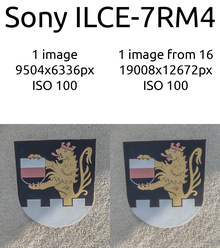This article includes a list of general references, but it lacks sufficient corresponding inline citations. (February 2020) |


Pixel shift is a method in digital cameras for producing a super resolution image. The method works by taking several images, after each such capture moving ("shifting") the sensor to a new position. In digital colour cameras that employ pixel shift, this avoids a major limitation inherent in using Bayer pattern for obtaining colour, and instead produces an image with increased colour resolution and, assuming a static subject or additional computational steps, an image free of colour moiré. Taking this idea further, sub-pixel shifting may increase the resolution of the final image beyond that suggested by the specified resolution of the image sensor.
Additionally, assuming that the various individual captures are taken at the same sensitivity, the final combined image will have less image noise than a single capture. This can be thought of as an averaging effect (for instance, in a pixel shift image composed of four individual frames with a classic Bayer pattern, every pixel in the final colour image is based on two measurements of the green channel).
An early pixel shift camera, the Kontron ProgRes 3012 digital camera, was used for the "Electronic Beowulf" project in the mid 1990s (https://www.uky.edu/~kiernan/welcome/1993.htm). The images were 3000x2000 pixels, 24 bit colour. Considered high resolution for the time.